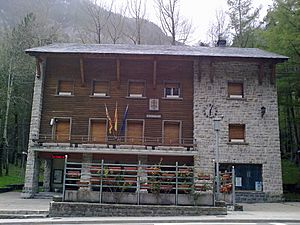Canfranc facts for kids
Canfranc is a small area in the Aragón Valley, located in north-eastern Spain. It's made up of two main parts: the original old village and a newer area called Canfranc Estación. The Estación part grew because of the big Canfranc International railway station. This station was built to help trains cross the Pyrenees mountains.
Where is Canfranc?
Canfranc is part of a larger area called the Jacetania comarca. A comarca is like a local district. Its main town is Jaca. Canfranc is also in the Huesca province and the Aragón region, which is an autonomous community in Spain.
Canfranc Village
The name Canfranc comes from Campus Franci, which means "field of the Franks". Long ago, it was a small market village. It also offered a resting place for pilgrims walking the Way of St. James. These pilgrims had just crossed the tough Pyrenees mountains over the Somport pass.
Sancho Ramírez, who was the King of Aragón, founded the village between 1080 and 1090. Canfranc also served as a guard post. It protected the borders and collected taxes. These taxes were given to the Cathedral in Jaca.
An important event happened here on October 29, 1288. The Treaty of Canfranc was signed. Edward I of England helped make peace. This treaty led to the release of Charles II of Naples, who was held prisoner by Peter III of Aragon.
The old village is in the valley of the Aragón River. It covers about 71.6 square kilometers (27.6 square miles). It sits high up at 1,040 meters (3,412 feet) above sea level. You can still see parts of an old Romanesque bridge for pilgrims. There are also two interesting churches. One is Nuestra Señora de la Asunción, built between the 12th and 16th centuries. It has four beautiful baroque altarpieces. The other is La Trinidad, from the 16th century.
Sadly, the village was badly damaged by fire in 1617 and again in 1944. After the second fire, most villagers moved to the nearby Canfranc Station area. Today, only about 77 people live in the old village.
Canfranc Station
The village of Canfranc Estación is higher up, at 1,190 meters (3,904 feet). It has a population of 454 people. This village mostly grew because of the Pau–Canfranc railway. This railway line opened on July 18, 1928, crossing the Pyrenees. Canfranc Estación is famous for its huge, old railway station. It was built for trains from Spain and France to meet. This was needed because the two countries used different railway track sizes.
The railway line closed after an accident on March 27, 1970. A bridge at L'Estanguet was destroyed. The French side of the station was then left empty and fell apart.
There are stories about "German gold" arriving here during World War II. Also, British spies used the station to move information and people from Vichy France.
Today, two trains a day run between Canfranc and Zaragoza. Since 2010, Spanish and French governments have talked about reopening the line for international trains. As of 2016, they planned to do this by 2020.
The old railway's Somport Tunnel (7,874 meters or 25,833 feet long) is now used for emergencies. It serves the main motorway's Somport Tunnel (8,602 meters or 28,222 feet long). It is also home to the Canfranc Underground Laboratory.
Celebrations
Canfranc-Pueblo (the old village) celebrates the Assumption of Mary on August 15. This is for its patron saint. Canfranc Station has its festivities on July 18. This day marks the anniversary of its train station opening.
Twin Towns
Canfranc is twinned with these towns:
 La Concordia, Jinotega, Nicaragua
La Concordia, Jinotega, Nicaragua Aspen, Colorado, United States
Aspen, Colorado, United States
See also
 In Spanish: Canfranc para niños
In Spanish: Canfranc para niños




